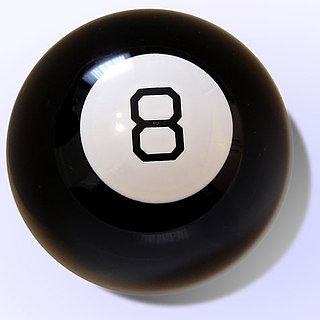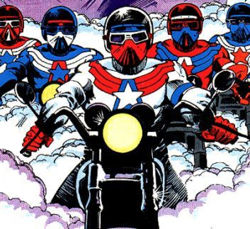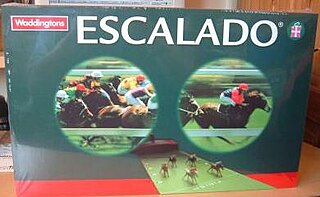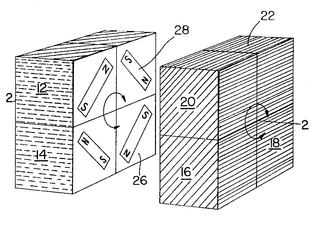
The Magic 8 Ball is a plastic sphere, made to look like an oversized eight ball, that is used for fortune-telling or seeking advice. It was invented in 1946 by Albert C. Carter and Abe Bookman and is currently manufactured by Mattel. The user asks a yes–no question to the ball, then turns it over to reveal an answer in a window on the ball.

A Slinky is a precompressed helical spring toy invented by Richard James in the early 1940s. It can perform a number of tricks, including travelling down a flight of steps end-over-end as it stretches and re-forms itself with the aid of gravity and its own momentum, or appear to levitate for a period of time after it has been dropped. These interesting characteristics have contributed to its success as a toy in its home country of the United States, resulting in many popular toys with slinky components in a wide range of countries.
A Snakeboard, also known as streetboard, or pivotboard is a board that was invented in South Africa in 1989 by James Fisher, Simon King and Oliver Macleod Smith. The concept was to fuse the original skateboard with elements of snowboarding and surfing to create a fun riding experience. The first prototype was constructed using two square wooden boards, an old roller skate chopped in half, and a piece of plumbing pipe to join them together. Many variants were tried before manufacturing began. The first boards to be mass-produced were made from a strong plastic nylon known as Zytel ST801.

A pannier is a basket, bag, box, or similar container, carried in pairs either slung over the back of a beast of burden, or attached to the sides of a bicycle or motorcycle. The term derives from a Middle English borrowing of the Old French panier, meaning 'bread basket'.

A swing is a seat, often found at playgrounds for children, at a circus for acrobats, or on a porch for relaxing, although they may also be items of indoor furniture, such as the Latin American hammock or the Indian oonjal. The seat of a swing may be suspended from chains or ropes. Once a swing is in motion, it continues to oscillate like a pendulum until external interference or drag brings it to a halt. Swing sets are very popular with children.

Vehicles that have two wheels and require balancing by the rider date back to the early 19th century. The first means of transport making use of two wheels arranged consecutively, and thus the archetype of the bicycle, was the German draisine dating back to 1817. The term bicycle was coined in France in the 1860s, and the descriptive title "penny farthing", used to describe an "ordinary bicycle", is a 19th-century term.

Super Soaker is an American brand of recreational water gun that uses manually-pressurized air to shoot water with greater power, range, and accuracy than conventional squirt pistols. The Super Soaker was invented in 1989 by engineer Lonnie Johnson. The prototype combined PVC pipe, acrylic glass, and an empty plastic soda bottle.

Dymkovo toys, also known as the Vyatka toys or Kirov toys are moulded painted clay figures of people and animals. It is one of the old Russian folk art handicrafts, which still exists in the village of Dymkovo near Kirov. Traditionally, the Dymkovo toys are made by women.

A rocking horse is a child's toy, usually shaped like a horse and mounted on rockers similar to a rocking chair. There are two sorts, the one where the horse part sits rigidly attached to a pair of curved rockers that are in contact with the ground, and a second sort, where the horse hangs on a rigid frame by iron straps the horse moves only relative to the frame, which does not move.

A mechanical hackamore is a piece of horse tack that is a type of bitless headgear for horses where the reins connect to shanks placed between a noseband and a curb chain. Other names include "hackamore bit", "brockamore", "English hackamore", "nose bridle" and "German hackamore". Certain designs have been called "Blair's Pattern" and the "W. S. Bitless Pelham".

Thunderiders is a fictional superhero/motorcycle team appearing in American comic books published by Marvel Comics. The characters were originally known as Team America, a property and toy line Marvel licensed from Ideal Toy Company. Team America first appeared in Captain America #269. They were renamed the Thunderiders in Thing #27.
Blaze was a rocking-horse toy produced by Mattel toymakers and introduced in 1961. Blaze was featured prominently during children's television advertising. Unlike other rocking-horses of the time, Blaze was mounted on a stand that was said to be "untippable" and had no springs. The apparatus prevented pinched fingers, and was fitted out with a mechanism that moved the horses legs in "real life action." Another Mattel feature allowed Blaze to talk when you pulled his "Magic Ring." His talking voice unit was the very same one produced by Mattel and unveiled in 1960 in its talking Chatty Cathy doll, and later toys like the Talking Mister Ed puppet. Blaze could say 11 different things like, "How about some hay?"; he could also whinny and neigh. A toy like this, that could gallop and move realistically when the horse was rocked forward and backward, was something special.

Escalado is a horse racing game created in the United Kingdom in which model race horse game pieces, originally made of lead, would make their way across a long fabric race track towards the finish line at the other end. The horses would move across the race track by means of a mechanical hand crank that vibrated the entire track in a random fashion such that it would simulate the events of a live race.

Playground slides are found in parks, schools, playgrounds and backyards. The slide is an example of the simple machine known as the inclined plane, which makes moving objects up and down easier, or in this case more fun. The slide may be flat, or half cylindrical or tubular to prevent falls. Slides are usually constructed of plastic or metal and they have a smooth surface that is either straight or wavy. The user, typically a child, climbs to the top of the slide via a ladder or stairs and sits down on the top of the slide and slides down the chute.

The Fleshlight is a brand of artificial vagina, oral, or anal sex toy. It is a masturbatory aid, which is used by inserting the penis into its opening.
Bonnie D. Zacherle is an American illustrator and designer who now resides in Warrenton, Virginia. Zacherle is known as the original creator of the best-selling My Little Pony toy line. She is also the creator of Nerfuls. Zacherle has done some outside consulting for Bliss House, an American licensing consultancy, on the graphics and product development side. In 2003, she became a member of 'Women in Toys'.

Jesse Armour Crandall was an American inventor and toy-maker. He had taken out over 150 patents on toys in his 75 years of inventing. Crandall's father, Benjamin Potter Crandall, was also a toy-maker as well as three of Jesse's brothers. Unlike his brothers who remained primarily associated with their father's toy business in New York City, Jesse started his own company in Brooklyn. It was a friend, perhaps Henry Ward Beecher, who named him "The Child's Benefactor". This became his trademark and slogan.
Rainbow Loom is a plastic tool used to weave colorful rubber and plastic bands into decorative items such as bracelets and charms. It was invented in 2010 by Cheong Choon Ng in Novi, Michigan.
Nosco Plastics, Inc. was the plastics molding division of National Organ Supply Company created in 1934 to make plastic parts for electric organs and was located at 1701 Gaskell Avenue, Erie, Pennsylvania, 16503. Beginning in 1948 with the implementation of the newly developed screw injection molding process, NOSCO quickly became a major early producer of tiny plastic toys called "slum" sold to wholesalers as carnival merchandise, used by the millions as prizes in packages of Cracker Jack popcorn confection, and mail-order flats that were heavily advertised in American comic books as "100 Toy Soldiers for $1" by E. Joseph Cossman & Company. NOSCO also held a number of patents on plastic molded products including mechanical toys, storage containers, pallets, and medical syringes.

Larry D. Nichols, born 1939 in the United States, is a puzzle designer. He grew up in Xenia, Ohio, and studied chemistry at DePauw University in Greencastle, Indiana, before moving to Massachusetts to attend Harvard Graduate School. He is best known for the invention of mechanical puzzles including 'The Nichols Cube Puzzle' (1974), patent US365520. He has lived with his wife Karen in Arlington, Massachusetts since 1959.















